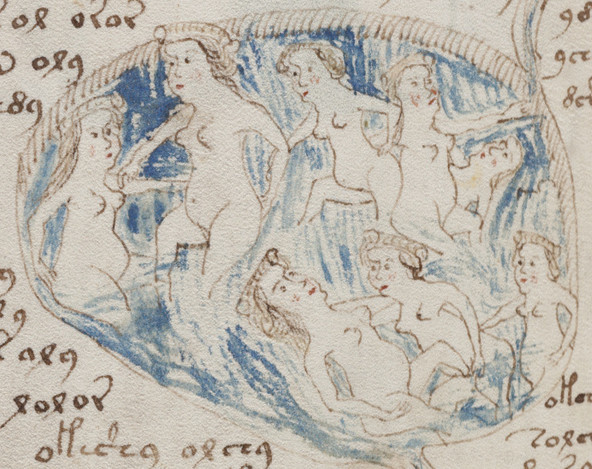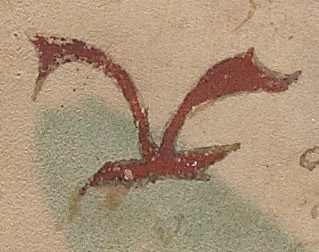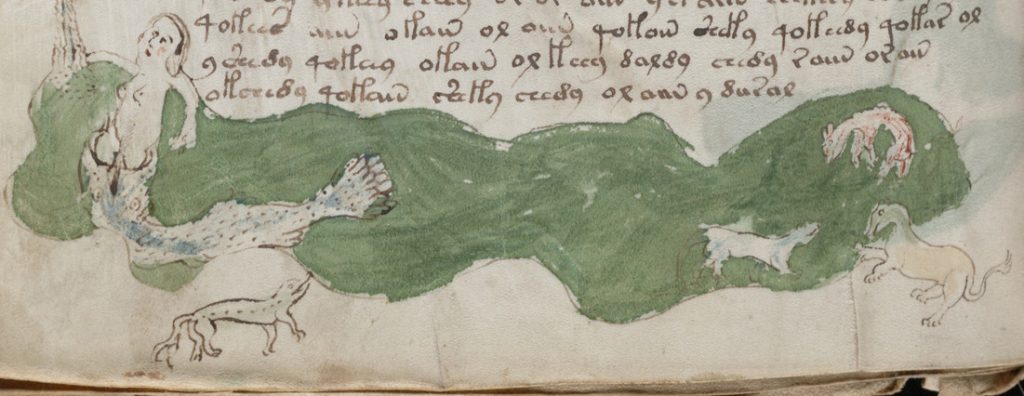If asked who the greatest historical codebreaker was, would I point to Jim Reeds, Jim Gillogly, or even William Friedman? No! That accolade would surely have to go to Dan Brown’s Robert Langdon.
Like, why? Well, despite the twin handicaps of (a) being accompanied by much younger, sexy sidekicks, for whom his awkwardly lustful old-guy feelings constantly get in the way, and (b) being a thinly drawn fictional character being played by a thinly drawn actor who was much better in ‘Big’, Langdon does solve some kick-ass cipher mysteries. Which is cool.
And so I recently set out to solve the kick-ass cipher mystery that is the Voynich Manuscript using Robert Langdon’s historical cipher playbook as my only guide. And boy oh boy, you’ll never guess where that led…
Birds of a Feather / Flock Together
So how would Langdon begin? Duh! Obviously, he’d turn to the very first page of the manuscript, where an obscure detail (that everybody had looked at before but glossed over) would, in his cavernous brain, trigger some insanely erudite / off-the-wall connection that nobody else could ever make, ever. And he would then have the intellectual courage to follow its trail of breadcrumbs through to its logical end, no matter what awful truth (usually guarded by some millennia-spanning conspiracy) it revealed.
So let’s channel our inner Langdon, and look in the upper left side margin of the first page of the Voynich Manuscript (folio 1r). This is what we see:
“Why, that couldn’t be…”, Langdon would muse, “or… could it?” Yes, it can!
I think you (and Robert Langdon) would surely agree that what is on the first page of the fifteenth century Voynich Manuscript is, without any doubt, essentially the same logo used by Californian children’s faux surf-wear company Hollister. But how? Wasn’t Hollister founded in 1922?
Now, Langdon would immediately know (as sure as if he had Wikipedia open on his leather-bound tablet) that Hollister was a fake brand concocted by Abercrombie & Fitch in July 2000 to help them target a younger market, and that all the talk of it having been created in the 1920s was just made up.
But at this point, Langdon’s eyes would narrow and his forehead would furrow slightly, and he would say something enigmatic in Italian: eppur si muove – “…and yet it moves clothes“. Or something like that.
Despite the logical difficulties, he would be immediately convinced that the two seagulls shared a subtle connection, one that he would have to travel to a long stream of good-looking locations to pursue. After all, what does Langdon ever have to lose, apart from his stellar reputation, his cushty academic job, and the lives of his ex-lovers and oldest friends as they accidentally get caught in the (literal) cross-fire?
And once he had reviewed all the available evidence (say, ten minutes later), he would conclude that there was only one possible way that the propositional variables of the Voynich Manuscript and the Hollister logo could be connected. How? You guessed it – a centuries-old conspiracy one of his nutty old mentors (who probably originally worked with Edgar Wind, but let’s not hold that against him) had once mentioned to him in hushed breath after an exhilarating iconographical lecture at the Warburg Institute… a conspiracy with a terrible, awful, powerful name he could never forget, no matter how hard he tried…
“The Secret Order of the Seagull”
Langdon would also instantly recall that Abercrombie and Fitch had been founded in 1892 by Establishment favourite David Abercrombie, initially selling outdoorsy apparel and related stuff from his Manhattan shop. Yes, Langdon would muse (thinking out loud over a Bellini to an old girlfriend who he had just randomly met on a traghetto in Venice, and who would be sadly heading to her doom in a couple of reels’ time) David Abercrombie was clearly the inheritor of a terrible age-old secret. Look, it’s obvious – you can tell by his moustache and sad mouth, for sure.

But who had been the Grandmaster of The Secret Order of the Seagull before Abercrombie? Well, only Anton Chekhov (not the Star Trek navigator, but the Russian playwright, *sigh*) could fit that bill. And after the disastrous 1896 debut of his play “The Seagull”, Chekhov must surely have sold the dreadful secret he had been looking after to Abercrombie on a outdoors goods buying trip to Moscow.
And yet… might some aspect of the secret also be embedded in The Seagull? In its Act II, which Langdon inevitably has memorized in the original Russian, we find the following:
Nina lingers behind after the group leaves, and Konstantin shows up to give her a seagull that he has shot. Nina is confused and horrified at the gift. […] Trigorin sees the seagull that Konstantin has shot and muses on how he could use it as a subject for a short story: “A young girl lives all her life on the shore of a lake. She loves the lake, like a seagull, and she’s happy and free, like a seagull. But a man arrives by chance, and when he sees her, he destroys her, out of sheer boredom. Like this seagull.“
“Now, wait a minute”, notes Langdon to a mysterious young lady who has easily sidled into his stuffy, egocentric life, “I’m sure that’s something I’ve seen in the Voynich Manuscript”.
“I think you could be right”, replies the sexy lady whose paper-thin backstory didn’t really make much sense, now you come to mention it. But given that she arrived at a point when Langdon had his mystery-solving head wedged several miles up his mystery-solving ass, he wouldn’t even have noticed if she had seven heads and ten horns. “It certainly looks like a woman by a lake. Even if she is apparently being eaten by a giant fish.”
Homer, But Not Simpson
But Langdon is wracking his colossal brain yet further, like a Greek fisherman beating squid on a rock to tenderize it. “Why is it”, he asks plaintively, “that Homer compared Hermes to a seagull?”
“[he] sped on over the waves like the seagull that hunts for fishes in the frightening troughs of the barren sea and wets his thick plumage in the brine; like such a bird was Hermes carried over the multitudinous waves. But when he had reached that far-off island he left the violet ocean and took to the land until he came to a great cavern; in this [Kalypso] the Nymphe of the braided tresses had made her home, and inside this he found her now…”
“That’s very strange”, says the young girl, whose curious accent really should have flagged her to Langdon as a strange mix of German rifle champion, Sorbonne arts student and Estonian prostitute, had he not been so distracted by her pert body. “I believe”, she continues, passing him a Beinecke printout from her oddly capacious handbag, “that scene is also depicted in the Voynich Manuscript.”

“Clearly the second nymph from the left is Kalypso”, notes Langdon, flexing his encyclopaedic knowledge of the Classics. “Because, as the daughter of the Titan Atlas, she’s bound to be the fittest.”
“So you have reconstructed The Secret History of The Secret Order of the Seagull, all the way from Homer to Hollister”, sneers the girl, suddenly pointing her diamante-encrusted Mauser HSc at Langdon. “This arcane and dangerous knowledge will do you no good when you are (dramatic pause) dead. As a dead dodo who has died. And is dead.“
But just as the conspiracy gun girl is about to shoot, Langdon’s old girlfriend, returning from the bar with their next round of Bellinis, trips on the conspiracy girl’s handbag and falls between Langdon and the gun. She dies, Langdon lives (he is merely grazed by the bullet, of course), the gun girl escapes, and the Secret Conspiracy goes ever on.
You know it makes sense. You’ve read the book, right?
Yes, It’s All As Plain As Day, Fer Sher
So, will the Voynich Manuscript turn out to be linked to some ancient shady symbol-obsessed cabal, of the kind whose dusty evil doors Robert Langdon is doomed to forever find himself accidentally knocking on? Clearly only a fool (maybe even a fool with a History degree) would think otherwise.
Here, I’ve tried to stand shoulder to shoulder with Robert Langdon, letting his indomitable spirit and continent-spanning leaps of faith guide me as we trace the roots of the Voynich Manuscript together. For to one like him (and I can confirm that there are indeed very many like him, because they keep sending me their Voynich Theories, and then snarling that I’m an idiot for not being able to grasp their ineffable brilliance), these things are Easy Peasy.
Perhaps you can learn some important lessons from him too!




A nice story.
A pity it does not hold.
It has been well established that the works of Homer were forged too by Wilfrid Voynich in the Summer of 1910. He tried to sell them as the Travels by the Chinese Emperor Yao ( 2356-2255 BC) expecting to get a billion. References to Homer’s works predating 1910 apparently were also forged by Wilfrid who had acquired masses of unused parchment from all ages. Voynich was an expert at dating his parchments even without C14, so he could forge the documents using corresponding vellum’s to within 30 years of their targeted age. And of course then simply artificially age the resulting manuscripts.
You had me at “his mystery-solving head wedged several miles up his mystery-solving ass”…
🙂
Everyone has Voynich Theories, few answer simple questions thay can be checked. Does the Voynich have
heliocentric or geocentric models? Does the Voynich use Sexagesimal (Sumerian} number system ?
My theory for today that it was a portfolio for a scribe on the run.
In Sydney, the Opera House has a balcony just above sea-level where you can have a meal between doing touristy-things like surveying and imagining yourself superior to the natives.
A sign near the cash register reads, “No refund for food taken by sea-gulls”.
Fred: if only everyone was so easily pleased! 😉
Nick,
Just in case any reader mistakes the gist of your post – am I right in supposing what riles you isn’t the quite reasonable possibility that some of the Voynich text might be taken from ancient or classical works, but the ‘Langdon method’?
I don’t doubt for a moment you know we have manuscripts proving that (even) Homer’s works were copied in fifteenth-century Italy. One wonders how old the exemplars might have been, but that’s a problem of text-criticism.
Diane: none of it riles me, I’m just celebrating how wonderful it is that cipher researchers have such a great role model in Robert Langdon. Heaven only knows how many Voynich theories out there have already been inspired by him, and how many more we have to look forward to in the future. As far as I’m concerned, he’s a toasty gift to us all that’s buttered on both sides. 🙂
The second you mentioned the seagull I could make out the logo for the North Haven cricket club.
Not bad for effort, but the seagull theory has already been pursued. The author of “Johnathan Livingstone Seagull” also wrote the “Messiah’s Handbook” which is a complete translation of the VM.
Patrick Lockerby: how can anyone argue with logic that good? And besides, “Messiah’s Handbook” is an anagram of “Semihobo’s Dhansak”, so there’s something for everyone there.
That, or “I Handshake Bosoms”. You choose.
LOL!!!
Did you know there’s an author here in the Netherlands who is praised as “the Dutch Dan Brown” and who’s actually written a thriller about the Voynich a few years ago? Donald Nolet – Handschrift van de Duivel.
I’ve read it. It’s horrendous. Comparing this guy to Dan Brown is an insult to Dan Brown. Which says a lot.
Drabkikker: thanks, that’s the first time I’ve heard of this book.
…and perhaps the last. :-/
So, I have a legitimate (?) Voynich question. Do we know how the characters were written? The stroke order, if that’s the proper term.
For example, in writing EVA “q”, was it like I was taught to write “4” – the downstroke, then start at the top again and do the down-left and cross-stroke without lifting the pen? Or was it a single stroke starting at the bottom, then up, left-down, right?
Similarly for EVA “o”, was it two half-arcs or a single circle, and if a single circle, where did it start and was it clockwise or counterclockwise?
(Apologies for not keeping to the topic.)
Can’t stop laughing! Thanks!
Ken, you can’t start at the bottom with a quill pen. If you go against the direction of the nib, the ink will spatter and blob.
Generally it’s top to bottom and left to right (if it’s a language that is written left to right).
You can connect some strokes (like side strokes). For example, you can go down and then swing to the right, but if you turn upwards more than a tiny bit, the quill will fight the direction and ink goes all over the place.
This is because the ink is held within the little hollow in the quill on one side. If it were on the other side, it would run down the nib instead of being dispensed gradually by pressure on the writing medium.
A ballpoint pen can go in any direction, but not a quill. Also, it has to be cut properly (and trimmed every few lines), and the direction and width of the cut affect the kind of line. Doing calligraphy with a dip pen (a metal one) is challenging. With a quill is even harder.
GIuseppi Bianchi: re your VM Ninja quest for help. Your blurred posted image is the right uppermost part of f1r and I guess Jason Davies has as good a focus and magnification range as anywhere.
Non aligned Letters a b c d e and possibly f & g are evident in the same right marginal region beneath the red moon blotch. Any idea what they might signify?